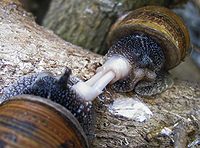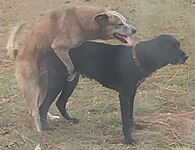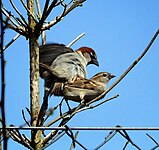Mating
This article needs additional citations for verification. (November 2013) |

(Ischnura elegans) mating
In
The term mating is also applied to related processes in bacteria,
Animals
For animals, mating strategies include
In some
Other animals reproduce sexually with external fertilization, including many
In domesticated animals there are various type of mating methods being employed to mate animals like Pen Mating (when female is moved to the desired male into a pen) or paddock mating (where one male is let loose in the paddock with several females).
-
Macaque monkeysmating
-
Gray wolves mating
-
Hermaphroditic snails (Cornu aspersum) mating
-
African spurred tortoises (Centrochelys sulcata) mating
-
Chalkhill blue butterflies (Lysandra coridon) mating
-
Hoverflies (Simosyrphus grandicornis) mating in midair
-
Poplar hawk-moths (Laothoe populi) mating
-
Ladybugsmating
-
Spittlebugs (Aphrophora alni) mating
-
Dogs mating
-
Goats mating
-
Cats mating
-
Birds mating.
Plants and fungi
Like in animals, mating in other Eukaryotes, such as plants and
Protists
Protists are a large group of diverse
However, to many biologists it seemed unlikely until recently, that mating and sex could be a primordial and fundamental characteristic of eukaryotes. A principal reason for this view was that mating and sex appeared to be lacking in certain
Protists generally reproduce asexually under favorable environmental conditions, but tend to reproduce sexually under stressful conditions, such as starvation or heat shock.[13]
See also
- Heterosexuality
- Animal husbandry
- Breeding in the wild
- Breeding season
- Evolution of sex
- Lordosis behavior
- Mate choice copying
- Mating system
- Reproduction
- Sex determination system
- Sexual conflict
- Sexual intercourse
References
- ^ The Free Dictionary. "'Fertilization' – definition of". Farlex, Inc. Archived from the original on 28 May 2022. Retrieved 25 January 2014.
- ISBN 978-1-108-69949-5.
- ISBN 978-0-226-87013-7. Archivedfrom the original on 1 August 2023. Retrieved 21 November 2016.
- ^ "What are yeasts?". Yeast Virtual Library. 13 September 2009. Archived from the original on 26 February 2009. Retrieved 28 November 2009.
- PMID 16339736.
- S2CID 205018792.
- S2CID 9441768.
- S2CID 17013247.
- S2CID 15991722.
- PMID 19359589.
- PMID 18663385.
- PMID 25800982.
- ^ Fowler, Samantha; Roush, Rebecca; Wise, James (2013). "Chapter 13: Diversity of Microbes, Fungi, and Protists". Concepts of Biology. OpenStax. Archived from the original on 19 April 2021. Retrieved 13 November 2020.














